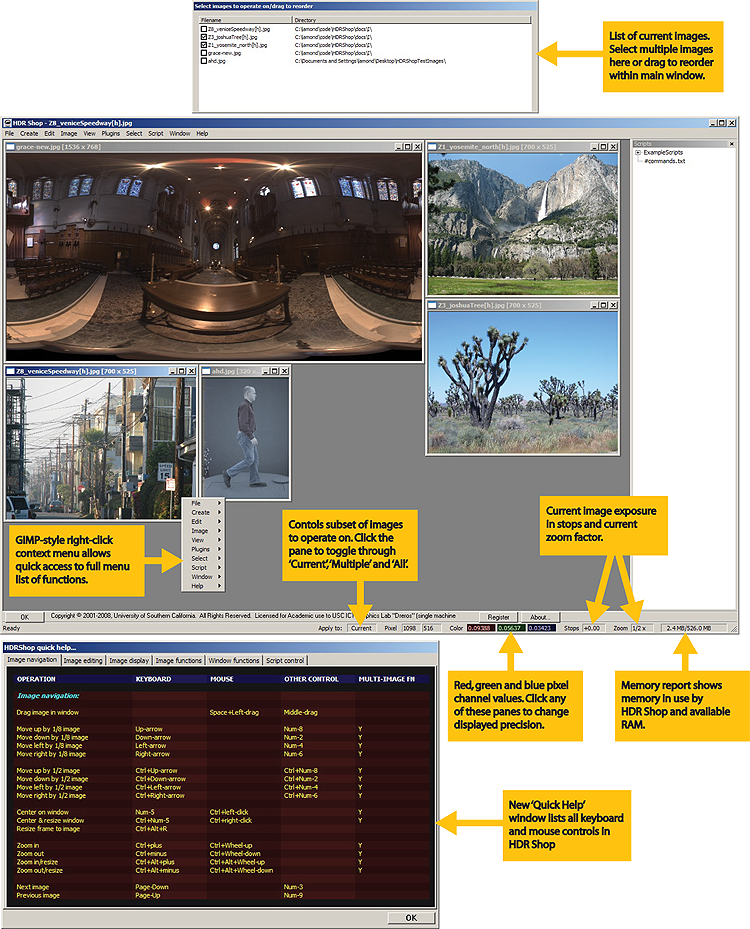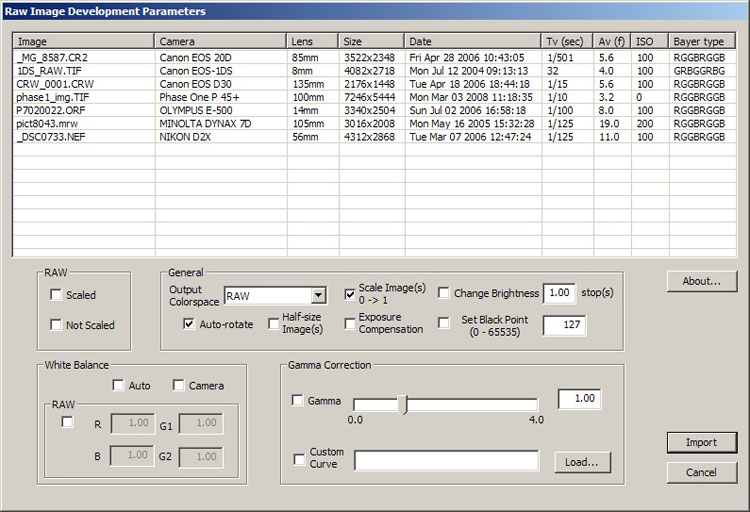Next: Getting Help Up: Getting Started Previous: HDR Shop 1.0 &
What's New in HDR Shop v3.0 ?
- Improved user interface
New GUI features:
- Color-coded pixel channel display:
The display of pixel channel information can be altered to display values with 3,5 or 8 decimal places or in scientific notation by clicking on a colored pane, or pressing 'Shift+3/5/8' or 'Ctrl+Shift+3/5/8' for scientific notation, or from the menu by 'View Display Options
Display Options Precision
Precision '
'
- Memory report pane showing memory being used by HDR Shop against available RAM.
- Expanded right-click context menu with full cascading menu access.
- Multiple image select/reorder images tool:
See below (4) or 15.15 for more information. - Quick help window displaying all keyboard and mouse controls in HDR Shop.
- Color-coded pixel channel display:
- Support for versions of Windows newer than Windows XP 32-bit
We have tested the latest release of HDR Shop on Windows Vista and Windows 7 without any problems. The software also runs without any problems on 64-bit versions of XP/Vista/7, although we have not as yet created a 64-bit optimized version of HDR Shop. - New built-in and external help documentation
Includes this document in PDF or HTML formats, and a new Quick Help window which lists all keyboard and mouse controls in HDR Shop. Accessed via the 'Help' menu or 'Ctrl+H' - Improved HDR assembly
HDR Shop 2.0 had two mechanisms for creating HDR images from image sequences - one for LDR images and one for Canon RAW images. These interfaces have been combined into one new interface, which now allows you to create HDR images from any LDR, HDR or RAW format using either image pixel values or EXIF file metadata to guide the assembly. Furthermore, the assembly algorithm has been improved by the addition of a new dynamic weighting scheme that takes any non-constant change in exposure within the image sequence into account. See this tutorial for more practical guidelines. - Improved support for RAW images
Support for RAW images has been improved from HDR Shop 2.0 which only supported a handful of Canon cameras in the old CRW format. The RAW importer in HDR Shop v3.0 is completely new and supports all major manufacturers RAW formats including:
- Canon (*.crw, *.cr2, *.tif)
- Nikon (*.nef)
- Kodak (*.dcr, *.kdc, *.dc2, *.k25)
- Fuji (*.raf)
- Olympus (*.orf)
- Minolta/Konica (*.mrw, *.arw, *.mdc)
- Pentax (*.pef)
- Sony (*.srf)
- Adobe Digital Negative (*.dng)
- Casio (*.qvs, *.bay)
- Panasonic/Leica/Casio (*.raw)
- Sigma (*.x3f)
- Epson (*.erf)
- Imacon/Hasselblad (*.fff)
- CREO (*.mos)
- Fotoman (*.pxn)
- Ricoh (*.rdc)
The new RAW importer:
The RAW importer uses dcraw by Dave Coffin.
See this tutorial for information on importing RAW images. - External batch-processing of HDR, RAW, and LDR images
HDR Shop v3.0 includes a small command-line tool ('rawTool.exe') allowing offline batch processing of large numbers of images. Batch processing can be used for creating HDR images or converting images from one format to another. The command line tool performs these processes significantly faster than a Javascript script called from within HDR Shop. Also included is a small command line tool (batchGen.exe) allowing creation of simple batch files for users who have limited experience in writing scripts or more involved programming. See this tutorial for instructions on using the rawTool. - New built-in light probe sampling tool
Light probe sampling was only available in HDR Shop 2.0 as an external plugin using the 'Median Cut' method. We have written this function into HDR Shop v3.0 and have also improved on it with the addition of a new 'Variance Minimization' sampling technique. See this tutorial for instructions on using the probe sampling tool. - Modified multi-threaded queuable architecture
This feature has been retained in HDR Shop v3.0, modified to ensure that images now load in the correct order. In HDR Shop 2.0 loading several images simultaneously produces a random ordering of the images because of asynchronous multi-threading. In HDR Shop v3.0 loading of multiple images is treated as a single thread which preserves the original ordering of the images. None of the images in that particular thread can be utilized until all have been loaded. However this does not prevent the user from operating on other open images while the current images are being loaded.
A related new image reordering facility has also been added to HDR Shop v3.0 (next item). - New image management window
New popup window which tracks the state of all open images in HDR Shop enabling two distinct functions:
- The order of the images can now be changed by a simple drag and drop operation.
- Multiple images can be chosen and any multi-image enabled operation (most HDR Shop
functions) can be performed on that set of images.
- The order of the images can now be changed by a simple drag and drop operation.
- Color matrix determination, reference Macbeth charts for mapping to common color spaces
Create a reference color-checker chart or use to color balance images to common color spaces like sRGB or AdobeRGB. See 8.5 or see this tutorial for more information. - Support for more current file formats
* HDR Shop v3.0 now supports all common proprietary digital RAW formats.
* New plugins supporting reading & writing of Portable Network Graphics (PNG) and JPEG-HDR formats.
* Support of larger subset of OpenEXR file formats:- 16-bit signed float.
- 32-bit signed float.
- 32-bit unsigned integer.
- Any 1, 2 or 3 channels, or grayscale.
- Any of the lossless compression methods (None/RLE/Zip/Zip16/PIZ/PXR24)
* Support for reading/writing PPM files in any combination of rgb/grayscale, 8-bit(uchar)/16-bit(ushort).
* Support for writing JPEG/JPEG-HDR with a specified 'quality' (as a %).
* For those image parameters that can be deduced on reading the image, HDR Shop now 'remembers' them between subsequent File Save operations, transferable across different formats (eg an image loaded from a grayscale EXR
file will default to saving as grayscale if saving as a PNG file).
Save operations, transferable across different formats (eg an image loaded from a grayscale EXR
file will default to saving as grayscale if saving as a PNG file).
- Improved camera curve calibration tool
The camera response curve calibration tool released in HDR Shop 2 was not able to produce sufficiently robust results. The tool has been re-written for the version 3 release and the results are now significantly improved. The tool now also supports drag and drop of images as input. See this tutorial for more practical guidelines. - Miscellaneous new/improved functions
- Improved half-sizing. Uses a small blur kernel for a smoother result. See
'Image
 Size
Size Half Size (Slower/accurate)' 10.2.
Half Size (Slower/accurate)' 10.2.
- New 'Sharpen' (10.31) and 'Edge Detector' filters (10.38).
- New image tiling schemes. The stock 'Tile' Has been replaced with Tile horizontally/vertically
and a new 'Smart Tile' function. See 'Window
 ' (15.3, 15.4,
15.5) for more information.
' (15.3, 15.4,
15.5) for more information.
- Amalgamated image information window. Press 'I' or under 'Image
 Info
Info Average/Sum/Max/Min/RMS' this
window gives information about the Average/Sum/Max/Min/RMS Error values in the selected area.
Average/Sum/Max/Min/RMS' this
window gives information about the Average/Sum/Max/Min/RMS Error values in the selected area.
- Display of saturated pixel values can now be controlled. See 11.26 for more information.
- Arbitrary resize of images to dimensions of less than half fixed. Performing this operation caused the output to contain just black pixels. This is now fixed. See 10.6 for more information.
- Improved Interpolation of RAW Bayer pattern images. See 10.41 for more information.
- Command line switches added to HDR Shop. These switches can be added to a link to HDR Shop.exe to control
how the program starts up.
Currently supported switches:- '-f' = start in fullscreen mode.
- '-dp 0/1/2/3/4/5/6' = control how channel values are displayed at start:
0 = 3dp, 1 = 5dp, 2 = 8dp
3 = 3dp, 4 = 5dp, 5 = 8dp [in scientific notation]
6 = 0-255 (unsigned char from display buffer)
- Improved half-sizing. Uses a small blur kernel for a smoother result. See
'Image
Next: Getting Help. Up: Getting Started. Previous: HDR Shop 1.0 & Generated by Bruce Lamond on 2009-03-16
